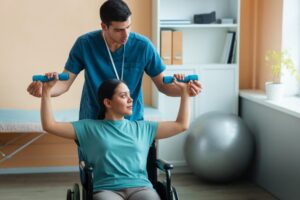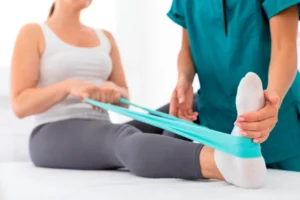The foot has a complex set of tendons, muscles, joints, and bones that enable it to work properly, as well as withstand walking, standing, and other everyday movements. Many health conditions and injuries, however, can upset the foot’s movement and balance, causing problems and pain.
Pain on top of the foot may seem like an unusual location, particularly if no obvious injury took place there. However, this area can be affected by a variety of conditions and injuries beyond a bone fracture or bruise. Foot pain is often caused by improper foot function. Poorly fitting shoes can worsen and, in some cases, cause foot problems. Shoes that fit properly and give good support can prevent irritation to the foot joints and skin. There are many types of foot problems that affect the heels, toes, nerves, tendons, ligaments, and joints of the foot.
The symptoms of foot problems may look like other medical conditions and problems. Always see your healthcare provider for a diagnosis. Most foot pain requires, at the very least, rest and extra care to heal. If the pain is due to an underlying health condition, additional medical care may be needed.
Metatarsalgia (Pain In Ball Of 1st & 2nd Toe)
Metatarsalgia is a blanket term for pain and tenderness in the ball of the foot caused by an underlying condition, such as the malalignment of one or more toes (as found in a bunion) or arthritis. Individuals with metatarsalgia experience pain of varied intensity and discomfort and find difficulty in activities like walking, running, playing, and several others.
Morton’s Neuroma
This is a condition that affects one of the nerves that run between the long bones (metatarsals) in the foot. The exact cause is not certain. Symptoms include pain, burning, numbness and tingling between two of the toes of the foot. About a third of people just need simple treatments including modification of their footwear.
Gout
Gout is a disorder that causes a painful buildup of uric acid in the joints. Although gout most commonly affects the big toe, it can affect the top of the foot and other areas of the body. It usually causes intense pain that comes on quickly, as well as redness, swelling, or tenderness in the affected area.
Corns
Corns are yellowish, callus growths that develop on top of the toes. Corns develop because of abuse or stress. Often, a corn develops where a toe rubs against a shoe or another toe. Corns can cause extreme discomfort and pain.
Ganglion Cyst
A ganglion cyst forms below the surface of the skin, appearing like a bump or sac filled with fluid. It often forms on top of the foot and may happen after an injury to the area. The cause of these cysts, however, is not always known. A ganglion cyst can cause pain if it is pressing against a muscle or joint in the foot. It may also cause tingling or burning if it is located near a nerve. If the cyst is large, it can cause discomfort or pain when it rubs against shoes.
Tendinitis
Tendinitis can occur in many different areas of the feet and legs. The extensor tendons, located in the top of the foot, are needed for flexing or pulling the foot upward. If they become inflamed due to overuse or wearing shoes without proper support, they may get torn or inflamed. This is known as extensor tendinitis, which can cause significant pain in the top of the foot. Extensor tendinitis pain usually gets worse with activity, and may also occur alongside swelling of the top of the foot. It may come about after excessive exercise or doing too much exercise, too soon.
Hammer Toe
Hammer toe is the most common deformity of the second, third, or fourth toe. It is often caused by wearing narrow shoes with little to no arch support. A hammer toe is a toe that has an abnormal bend in its middle joint, making the toe bend downward to look like a hammer. This painful condition forms due to an imbalance in the surrounding muscles, tendons, or ligaments that normally keep the toe straight.
Bunions
A bunion, also known as hallux valgus, develops on the big toe joint when the bones of the big toe become misaligned. It looks like a large bump on the side of the toe. The big toe angles in toward the second toe, and, in severe cases, may overlap or tuck beneath the second toe. Bunions are more common in women than in men.
Stress Fracture
A stress fracture is a small fracture in the bone, due to repetitive loading. Any activity that places high impact stress on the foot can lead to a foot stress fracture – for example running, tennis, netball, football. The most common place to sustain a foot stress fracture is in the metatarsal s- generally 2,3,4. During exercise the metatarsals are put under a great deal of stress as they act as the ‘bridge’ between the mid foot and the forefoot.
Causes Of Forefoot Pain
- Overuse.
- Wearing high-heeled shoes.
- Being overweight.
- Having a stiff ankle or Achilles tendon.
- Claw foot (pes cavus).
- Injuries.
- Toe length – if the second toe is longer than the big toe, most common forefoot condition for likely to occur.
- Certain diseases – people suffering from conditions like arthritis or diabetes are more likely to develop foot problems.
- Loss of fat pad under the ball of the foot – With aging, the protective fat pad under the ball of the foot tends to thin out with overuse and may increase the susceptibility to pain in the ball of the foot.
- Previous surgery to the foot. For example, previous surgery for bunions.
How FMT TM Helps?
FMT TM is a comprehensive system of evaluation and treatment through hands on techniques. This approach is based on three pillars: mechanical capacity, neuromuscular control & motor control. Our evaluation is focused on finding the root cause of pain and we rarely recommend for X-ray or MRI post evaluation. We treat the joint and muscles with hands on approach and then make sure we work on neuromuscular and motor control i.e reminding the brain of the efficient body position and movements. We educate the patient for exercises and postural advice specific to his/her body and ergonomic requirement so that change we have obtained are maintained. For runners and athletes or individuals with sedentary lifestyle or normal individuals, we can teach you the best way to accelerate, run and jump or jog or walk as well as correct ergonomics and body mechanics during high velocity activities, running, jogging and sports and fitness trainings, so that it does not feel or look robotic but comes naturally to you. It has been researched that if you move around or follow proper alignment and techniques during these activities or during day to day activities or if you play a sport with proper alignment and technique then the core stabilizing muscles of your upper and lower body segment will work efficiently and significantly reduces the chances of injury and pain in your foot.




